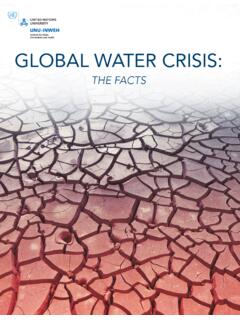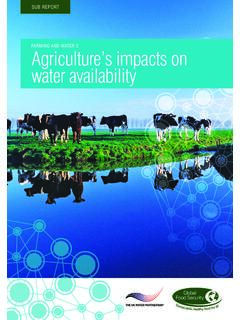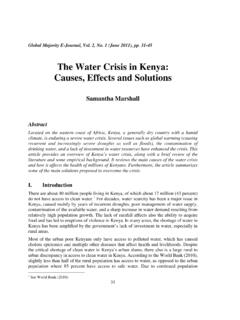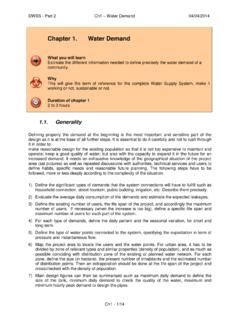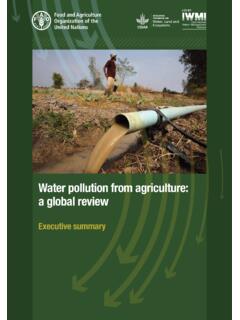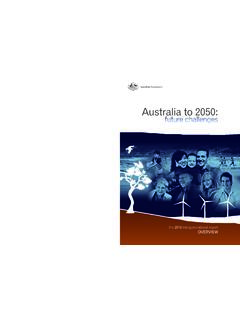Transcription of Water and Climate in the Pacific Northwest
1 Water and Climate in the Pacific Northwest INSTITUTE FOR Water AND WATERSHEDS OREGON Climate CHANGE RESEARCH INSTITUTE 8/2012. Water and Climate in Oregon and Washington (hereby the Pacific Northwest , or PNW) are inextricably linked. Here, we explore how Climate has changed and is projected to change during the 21st century, and the implications for Water in the PNW and greater western United States. How does Climate vary over the Pacific Northwest landscape? In the Water cycle, surface Water is both the accumulation from runoff from precipitation and groundwater. Precipitation can contribute to surface Water immediately, either in the form of rain, or delayed, in the form of snowmelt-driven runoff.
2 The seasonality of precipitation dictates the need for Water storage in the form of snowpack in the PNW; most of the precipita- tion falls between October and March. Historically, mountain snowpack has served as natural storage for summertime Water supply in much of the Pacific North- west. In the future, as winter temperatures warm, moun- tain snowpacks will continue to diminish and summer wa- ter supply will likely decline. Precipitation varies both spa- tially, or, across the land- scape, and temporally (through time). Mountain ranges play an important role in where precipitation falls in the PNW. The highest Figure 1.
3 PRISM data mapped on 21st century Climate services tool for Oregon and annual precipitation amounts Washington. PRISM data (PRISM Climate Group, , 21st Cen- are found on the windward, tury Climate Services developed by Alex Wiggins of Oregon State University for OCS. or, and funded by Microsoft Research, Bend and Eugene probability of at least of pre- cipitation in a 1-day period from Western Regional Climate Center). Water and Climate in the Pacific Northwest Oregon Institute for Water and Watersheds ( ) 1. upslope side of the ocean-adjacent mountain ranges. Parts of the Coast Range in Oregon and the Olympic Mountains in Washington can see around 200 inches per year of precipita- tion on average.
4 The Pacific Northwest is billed as an excessive- ly rainy place, but in reality, it does not live up to its wet reputation in the regions two largest cities: Seattle, WA and Portland, OR. Both cit- ies both receive less precipitation annually (on average less than 40 per year), than New York City or Miami. This reputation isn't root- ed in the amount of precipitation, but the number of days with rain. This rainy moniker is unfairly assigned to the entire Pacific North- west, when the inland areas east of the Cas- cades are actually quite arid. This is because the Cascade Mountains of Oregon and Wash- ington also create a rain shadow effect, keep- ing the inland areas mostly dry year-round.
5 The Cascades rain shadow can be described as such: ocean-influenced moist air masses are forced to rise when they meet the tall moun- tains. The rising air cools, condenses, and the moisture falls as precipitation. On the leeward (dry) side of the mountain, the now dry air warms and sinks. This is why Eugene, OR is rainier than Bend, OR, which is located direct- ly over the mountains to the east. The Oregon Coast Range and Olympic Mountains of Wash- ington produces a smaller, and somewhat less significant rain shadow; part of the reason that Newport, OR is wetter than Corvallis, OR, Figure 2. Shows temperature and precipitation distribution for interior Western Oregon for the months of January, February and March.
6 The directly to its east. red line shows the mean, the blue box indicates the 33% and 66% val- ues, and the end bars show the range from low to high for each mode General atmospheric circulation tends to dic- of ENSO: El Ni o, neutral (no signal detected in SST in ENSO area), and La Ni a. In this part of Oregon, the temperature signal is a little tate the timing of precipitation. The Aleutian more pronounced than the precipitation signal. The mid-range (33- Low is a semi-permanent atmospheric feature 66%) is different in temperature between El Ni o and La Ni a events, found in the general vicinity of the Aleutian Is- but there is overlap in the upper and lower ranges.
7 In precipitation, lands during the winter. Cyclonic flow tends to the range from low to high precipitation in El Nino and La Ni a events bring the flow and direct the general is greater than temperature, with overlap in the mid-range (33-66%) in stormtrack over the Pacific Northwest . In the warm, neutral, and cool phase conditions. summer, the low shifts north and an opposite, anticyclonic ridging pattern tends to set up over the Northwest , keeping summers dry and Water and Climate in the Pacific Northwest Oregon Institute for Water and Watersheds ( ) 2. warm. Rain that does fall in the summer tends to be the result of small-scale convective events.
8 Convective events usually bring short-lived bursts of heavy rainfall, and sometimes hail. These events are more typical east of the Cascades, where warm air required for ascent (a key element of thunderstorm development) is more free to mix with cold air aloft, triggering these events. We've covered where and when precipitation tends to fall, and when, but temperature also plays a crucial role in Water and Climate in the Northwest . Proximity to the ocean also keeps temperatures mild in the winter; Water doesn't cool as quickly as land. Winter, as we mentioned before, is the time of year when most of the precipitation falls in the Northwest .
9 These mild temperatures are close enough to the freezing point (0 C/32 F), especially in the lower-mid elevations, that often a few degrees difference will spell the difference between rain and snow. Modes of Climate variability affect Pacific Northwest weather and Climate on an interannual basis, namely the El Ni o Southern Oscillation (ENSO), which is marked by an area in the equatorial Pacific Ocean. This area is where coupled sea surface temperature and atmospheric variations drive the overall global atmos- pheric circulation pattern. The warm phase of ENSO, is known as El Ni o; the cool phase, La Ni a. In the Pacific Northwest , especially the western portion of the region, the phase tends to affect seasonal tempera- ture and precipitation.
10 El Ni o tends to split the jet stream, often bringing warmer air to Oregon and Washington and wetter weather to California. La Ni a tends to position the northern storm track directly over the Pacific Northwest , bringing greater odds of cooler, wetter winters. What are the overall trends in Climate ? How is human-caused Climate change effecting the Pacific Northwest ? What does Climate change mean for Water resources? Human activity is primarily responsible for the observed F increase in 20th century annual averaged temperatures in the Pacific Northwest , though a formal detection and attribution study has not been performed for this region.
